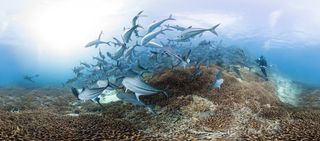
Aquatic Life Migrating to Poles as Temperatures Shift (Op-Ed)

Colin Cummings is a science intern at Oceana. This article was adapted from one that first appeared on the Oceana blog The Beacon. Cummings contributed this article to LiveScience's Expert Voices: Op-Ed & Insights.
Marine life is on the move. A groundbreaking study reveals that over the last several decades, warming ocean temperatures have caused many marine species to shift closer and closer to the poles. Some types of fish and plankton are moving at a rate of 45 miles per decade, 12 times faster than terrestrial animals. As the base of the marine food web moves, people will have to follow or risk losing a resource.
"That's like moving the dinner plate to a totally different place in the ocean," said paper co-author Benjamin Halpern, a research biologist with the National Center for Ecological Analysis and Synthesis at the University of California, Santa Barbara. As populations of marine organisms head towards the poles, tropical habitats and fishing grounds grow more desolate and non-native species flood the fragile ecosystems of the polar oceans.
But the poles may not be the most hospitable place for marine life in the near future. Since colder water naturally absorbs more carbon dioxide than warmer water, the poles are especially vulnerable to ocean acidification. A more acidic ocean may wipe out Antarctic krill, a vital prey species that supports most of the Southern Ocean food web. An unstable food-web base and a flood of animals fleeing warmer waters could lead to ecological collapse.
Scientists once believed that land animals would respond faster to climate change, but findings show that even small changes in ocean temperatures are having a severe impact on marine life.
"What these data show is that marine ecosystems are responding to environmental change, and they're responding at a faster rate than just simple metrics like mean global temperature rise would perhaps indicate," said Pippa Moore, another co-author and professor of aquatic biology at the Institute of Biological, Environmental and Rural Sciences at Aberystwyth University in the United Kingdom.
Society should be concerned by such findings. The results further support the hypothesis that ocean-based food security is threatened in a high-carbon-dioxide world. The changes may reduce the amount of wild-caught seafood that the oceans can provide and also redistribute species, changing the locations at which seafood can be caught and creating instability for marine resources. The least-developed tropical nations where residents eat large quantities of fish — and lack resources to adapt — may suffer the hardest from climate change and ocean acidification.
Sign up for the Live Science daily newsletter now
Get the world’s most fascinating discoveries delivered straight to your inbox.
While such impacts on marine ecosystems, livelihoods and food security are distressing, there are steps that we can take to minimize them. You can help Oceana combat climate change and ocean acidification and support clean, renewable energy sources such as offshore wind, so that the ocean's dinner plate, and our dinner plate, stays right where it is.
Cummings's most recent Op-Ed was How Acid Oceans Could Kill Krill. This article adapted from an article that first appeared as Marine Life Responding Faster than Land Animals to Climate Change on the Oceana blog The Beacon. The views expressed are those of the author and do not necessarily reflect the views of the publisher. This article was originally published on Live Science.
Most Popular

